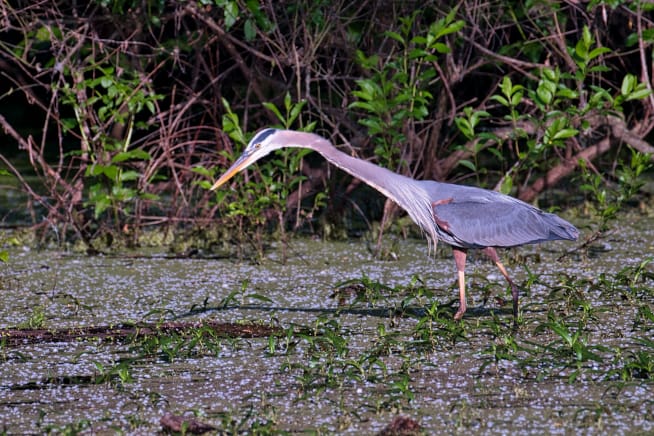I photographed this Great Blue Heron at Sequoyah National Wildlife Refuge in Oklahoma. It was standing in the water at Miner’s Cove, one of my favorite spots for photographing all kinds of wildlife. This heron had its neck extended, scanning the water for prey. When a Great Blue Heron does this, its head and eyes move slowly, focusing on any possible movement in the water.

When the heron spots potential prey, it folds its neck back, ready to strike. The process is sudden—its whole body unbends, and its sharp bill plunges into the water. Sometimes it catches the prey, sometimes it misses. This time, the heron struck but missed, coming up empty.
The heron did not stay at this spot for long. I think the floating debris made it hard for it to see prey clearly. The white material on the surface was from cottonwood trees. Cottonwood seeds are surrounded by small, cotton-like fibers that are released in the air and settle on the water during this time of year. The cottonwood fluff can make spotting fish or other small creatures tricky for birds.
Miner’s Cove is just north of the 4-corners intersection at the Sequoyah National Wildlife Refuge. I parked on the west side of the tour road to avoid disturbing the bird. From inside my pickup, I used a bean bag over the open window to stabilize my camera and lens.
Sequoyah National Wildlife Refuge is a rewarding location for wildlife enthusiasts. The diverse habitats draw in a wide range of animals, from Great Blue Herons and egrets to mammals like deer and raccoons. Miner’s Cove, in particular, offers many chances to see birds in action, especially early in the morning when the light is soft and the wildlife is more active.
Camera Settings
- Aperture: f/8
- ISO: 800
- Shutter speed: 1/1700 sec
- Exposure Compensation: -1.0
- Focal Length: 400 mm
Using these settings allowed me to freeze the movement of the heron as it scanned the water. The fast shutter speed was crucial for capturing any sudden action, like when it struck at potential prey. The aperture of f/8 gave me enough depth of field to keep the bird sharp while still blurring the background.
Miner’s Cove is a place I keep returning to because it always offers something new. Even when the heron didn’t catch its meal this time, it was an engaging moment to witness. Wildlife photography is about these quiet observations—watching, waiting, and respecting the natural behaviors of these remarkable birds.
